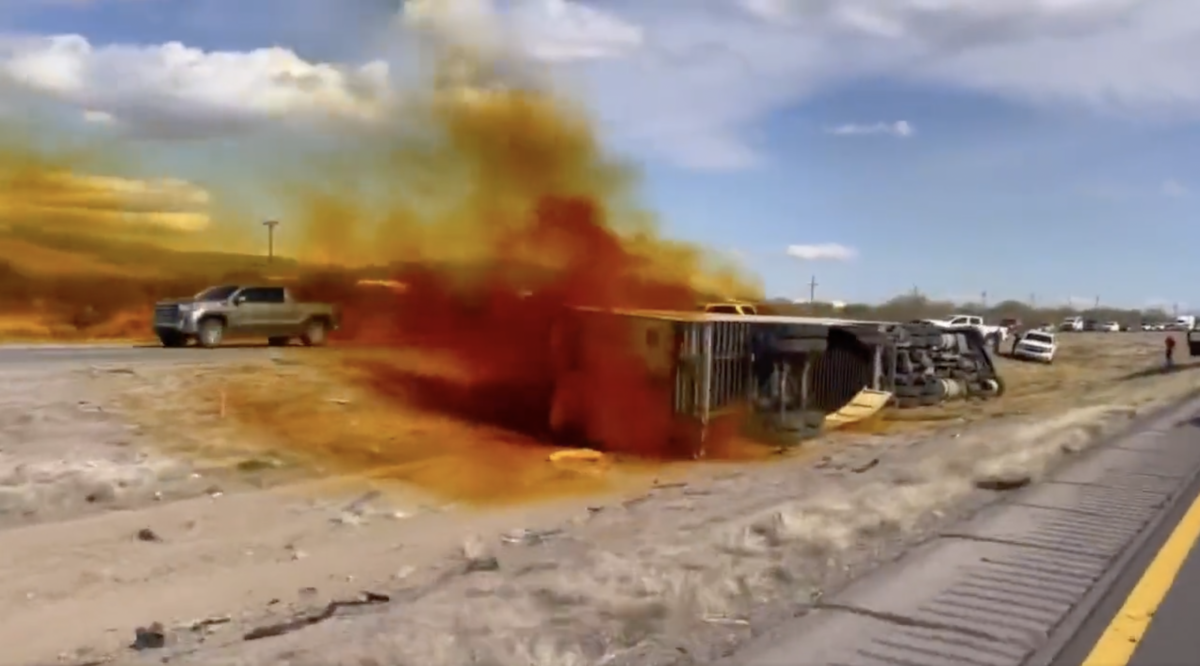A major highway safety advocacy group is asking U.S. Transportation Secretary Pete Buttigieg to crack down on the trucking industry following hazmat spills, including the railroad derailment in East Palestine, Ohio.
In a March 14 letter to Buttigieg, the Truck Safety Coalition (TSC) demanded action from the U.S. Department of Transportation (DOT) following recent hazmat spills including the one caused by a train derailment in East Palestine and another that occurred in February in Tucson, Arizona. In the Tuscon crash, a semi hauling nitric acid in liquid form rolled on eastbound I-10, killing the truck driver and forcing officials to issue a shelter-in-place order.
“It is past time to issue essential and overdue truck safety standards that will prevent hazmat crashes, save lives, protect communities, and put public safety ahead of corporate profits,” the TSC wrote.
The TSC specifically called for immediate DOT action on a number of trucking safety issues. See below for the group’s list of recommended action for DOT as laid out in the letter to Buttigieg:
Require Automatic Emergency Braking on All Commercial Motor Vehicles.
The Infrastructure Investment and Jobs Act (IIJA) (Pub. L. 117–58), enacted in 2021, mandated rulemaking for automatic emergency braking (AEB) in commercial motor vehicles (CMVs) subject to 49 C.F.R. 571.136. As long ago as 2015, safety groups petitioned the National Highway Traffic Safety Administration (NHTSA) to issue a standard requiring AEB on CMVs. Furthermore, research by the Insurance Institute for Highway Safety has found that AEB and forward collision warning could eliminate more than two out of five large truck rear-end collision crashes.7 The European Union has required AEB on nearly all heavy trucks since 2013.8 AEB is a well-known, well-researched, and well-performing technology to prevent truck crashes. We urge you to move expeditiously to issue a comprehensive AEB standard that mandates this technology on all new trucks and ensures that DOT meets the statutory deadline of November 2023.
Mandate Speed Limiters on All Commercial Motor Vehicles.
Speed kills. The safety benefits of controlling the speed of a CMV are incontrovertible. In 2016, FMCSA proposed its first speed limiter rule but has yet to issue a final standard. For far too long the FMCSA has taken a laissez-faire approach to speed-limiters that has, by FMCSA’s own calculations, cost thousands of lives. Studies have concluded that trucks using speed limiters were involved in half as many high-speed collisions as those not using speed limiters. Speed is often a causal factor in rollover crashes. Speed limiters, set no higher than 60 mph, must be required by DOT on all CMVs immediately. Already, speed limiting systems are required throughout world including in Canada, the United Kingdom and Australia.
Fatigue is a Major Problem in the Trucking Industry. The Hours-of-Service Rule Needs to be Reformed and Restored & Obstructive Sleep Apnea Rulemaking Must be Reinstituted.
In 2011, FMCSA issued a hours-of-service (HOS) rule, supported by 80 studies and economic analysis intended to save the lives of truck drivers and those of passenger vehicles from fatigued truck drivers. Following a lawsuit brought by trucking interests, FMCSA rolled back several key provisions, prompting National Transportation Safety Board (NTSB) Member Bruce Landsberg to conclude that the amended rule puts everyone on the road “at increased risk.”Furthermore, operating on a short haul exemption (which allows a maximum duty period of 14 hours with no logs books, when operating within 150 air miles of regular reporting location) increased crash risk by 383 percent. We urge you to restore the 2011 rule immediately and require a 30-minute rest break after eight hours of driving that does not allow non-driving work. Additionally, DOT should reinstitute the rulemaking requiring screening and treatment of safety sensitive personnel for obstructive sleep apnea, something DOT already requires of air pilots.
New Entrant Carrier Proficiency Exam is Essential.
Congress has twice directed FMCSA to develop a knowledge exam for new motor carriers, initially in 1999 and again in 2012.17 Years later, new motor carriers still do not have to prove to FMCSA that they know anything about the federal safety standards to participate in interstate commerce. This is also true for carriers seeking to haul hazardous materials, which is terrifying. New carriers need only sign a form stating that they are familiar with FMCSA safety requirements.18 In addition, entry-level drivers who are learning to properly transport hazardous materials are not required to accumulate a minimum number of behind-the-wheel (BTW) training hours.19 This is unacceptable. It is time to immediately complete the New Entrant Carrier Proficiency Exam rulemaking.
Anti-Safety Trucking Legislation in the 118th Congress Will Make Our Nation’s Dangerous Roadways Even Deadlier.
Current industry-led legislative proposals seek additional safety rollbacks that further endanger all roadway users and must be stopped. They include: Ceasing Age-Based (CAB) Trucking Restrictions Act (H.R. 267) and the Safer Highways and Increased Performance for Interstate Trucking (SHIP IT) Act (H.R. 471). Additionally, we remain opposed to the teen trucker pilot program mandated by the IIJA and continue to call for stringent oversight.
“The East Palestine train crash has revealed dangerous and deadly deficiencies in the rail transportation of hazardous materials. Perilous deficiencies are also ubiquitous in the truck transportation of hazardous materials. There are no defensible excuses for further delays when public safety is clearly at risk. We urge you to act now on mandating these imperative and overdue safety improvements,” TSC concluded.
